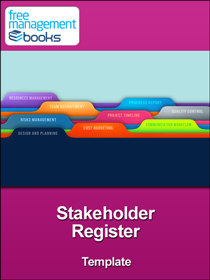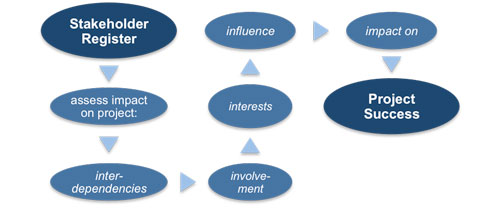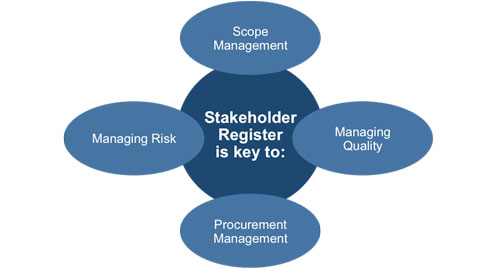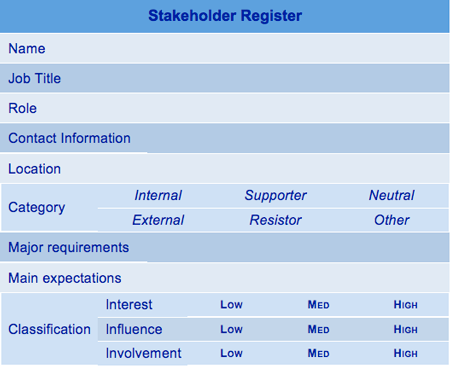
Stakeholder Register Template
This template records the output of identifying your project stakeholders and collates all the information required to understand the needs and expectations of each stakeholder enabling you to define the most appropriate way to manage this relationship.
This process involves assigning a category to each stakeholder that helps you classify the level of interest, influence and involvement in your project. It also documents the main requirements they want the project to meet and their expectations of what will happen on completion of the project in relation to their role and organization.
Stakeholders play a key role within any project and it is essential if you want your project to succeed that you understand their wants and hopes. Your ability to communicate in an appropriate manner with each one is critical to retaining their support and backing of your decisions. The stakeholder register enables you to document their interests in sufficient detail for you to categorize the level of communication they need and its contents. The common definition for a stakeholder is:
Any individual that has an interest in the project. It does not matter whether this interest is of a positive or negative nature.
In this definition the meaning of ‘individual’ encompasses both an organization and an individual. The interest they hold in the project may result from their active involvement in the project, or because they are affected by its implementation of or completion. The data held in the stakeholder register is based on acuity, observation and experience describing each one from the project’s perspective.
The creation of the stakeholder register starts with identifying who the individuals, groups and bodies that have a vested interest in the project and its outcome. The list of your stakeholders is one of the project plans crucial inputs. The register is not a static document and is expanded on with each subsequent processes of stakeholder management. Its key purpose is to ensure that the project manager and project sponsor fully understand how much influence each stakeholder can wield during the project and what their level of project engagement.

Stakeholder Register Template
Once the project manager has categorized each stakeholder in this manner then he or she is able to decide the best methods to communicate with them and what level of content is necessary to meet their personal requirements and expectations. The circulation of the stakeholder register is carefully controlled because of the sensitivity of its contents. If the ‘wrong’ people read or became aware of the document’s descriptions and observations of themselves and others it could cause political conflict if people became aware of its. It may even damage an individual’s career or sour relations with a supplier or agency.
The register is a central plank of the stakeholder management plan as it helps to ascertain the best way to plan communications with each stakeholder and control what is communicated and the most appropriate timing and level of detail. Its importance impacts other project areas as shown in the diagram below and the overall success of the project.

Stakeholder Processes
There are several key aspects of project management where the stakeholder register plays an essential role. One is in ensuring that the scope includes only the work packages that are necessary to perform all the work required to meet the project objective. Another area is managing quality and ensuring the desired quality of the final product meets user and stakeholder requirements.
This part of the quality management plan consults with appropriate stakeholders and the members of the project team to ensure there is a common understanding of how the system will work in reality.
Every project undertaken faces an element of risk; its success depends on the team’s ability to identify potential risks and planning how they will be tackled if they occur. Stakeholders must play an active role in this process to ensure all possible risks are considered and classified correctly in terms of the project and not their personal views or aspirations.
Use of external agencies and organizations is a natural part of any project and stakeholders have a part to play in the planning of procurement. They may have skills and expert knowledge that would be invaluable to discerning the most appropriate third parties to incorporate into the project team.

Stakeholder Register
Even though it is a legitimate document, in that it helps the project manager to communicate with all those listed, the information it contains can be sensitive and is one perception at a specific point in time. This makes the register a potential source of controversy.
For example, a departmental head might be described as having a negative attitude to the project because it will have an adverse impact on them personally. However, he or she could feel that they are being unfairly misrepresented in a way that could damage their future prospects within the organization. For this reason, this document should be available only to the project manager and perhaps one or two trusted project staff.
